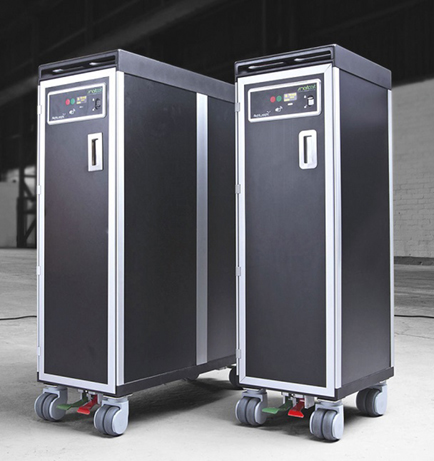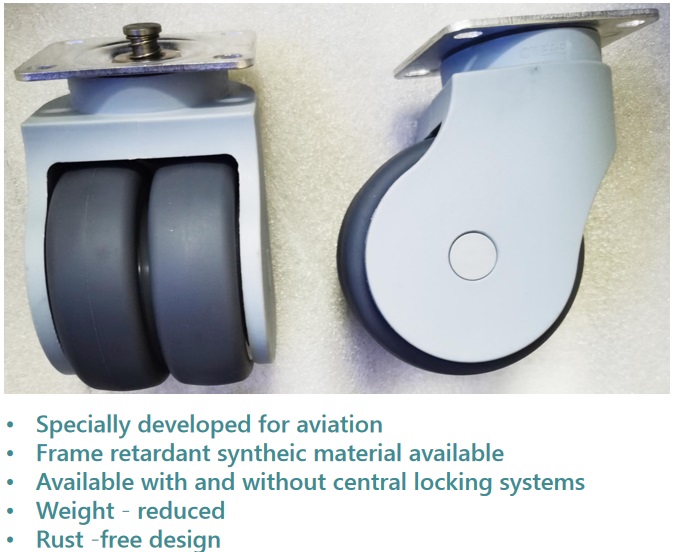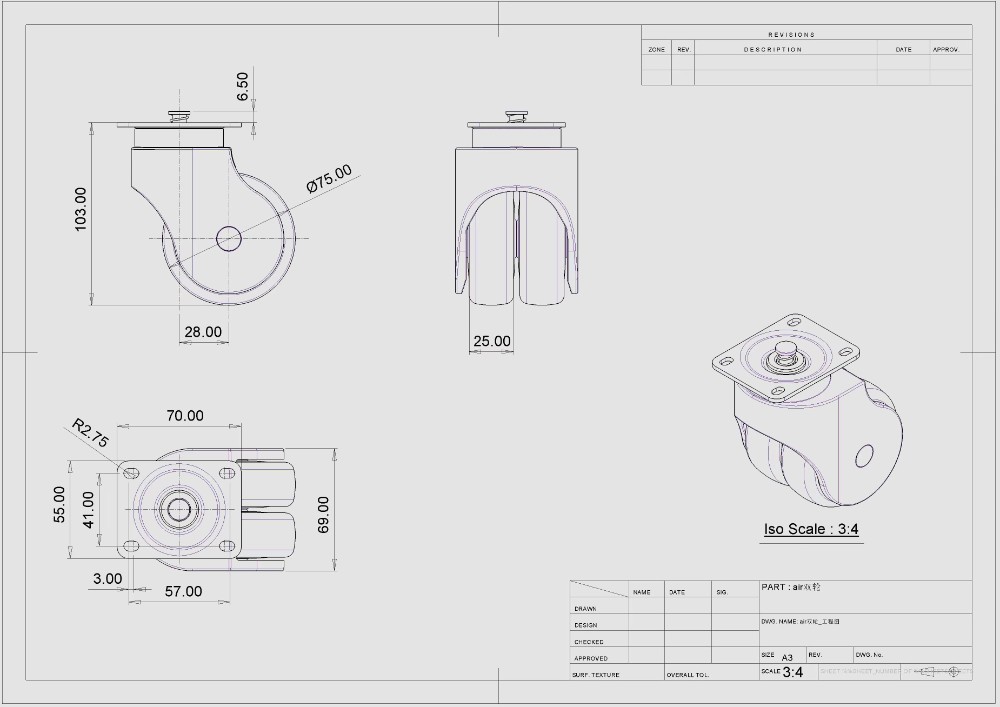- Best Price! Direct China Factory!
- Send Inquiry
WhatsApp/WeChat: 0086-137-36454395
Airline trolley casters are crucial components of onboard service equipment used by flight attendants and cabin crew to transport food, beverages, and other items during flights. These casters must meet strict safety and performance requirements to ensure the smooth operation of onboard services and to minimize the risk of fires in the aircraft cabin. In this article, we will explore why airline trolley casters need to be both flame retardant and lightweight, and how these characteristics contribute to the safety and efficiency of airline operations.
Flame Retardant Characteristics
Fire safety is a top priority in the aviation industry because of the high risk of fires in the confined spaces of aircraft cabins. The Federal Aviation Administration (FAA) has established strict fire safety regulations for aircraft interiors, including requirements for materials used in onboard equipment such as airline trolley casters. Fire-resistant caster wheels help to minimize the risk of fires and improve the safety of aircraft passengers and crew in several ways:
Slow Down Flame Spread: Fire-resistant caster wheels can slow down the spread of flames in the event of a fire onboard, reducing the risk of catastrophic damage to the aircraft and increasing the chances of safe evacuation.
Minimize Smoke Emissions: Fire-resistant materials release fewer toxic fumes and smoke when exposed to heat or flames, reducing the risk of respiratory damage to passengers and crew.
Contain Fires: Fire-resistant caster wheels can help contain fires in their early stages and prevent them from spreading to other areas of the aircraft, allowing emergency response teams to control the situation before it becomes critical.
Meet Regulatory Requirements: Airlines must comply with strict fire safety regulations set by aviation authorities such as the FAA and the European Aviation Safety Agency (EASA). Fire-resistant caster wheels enable airlines to meet these regulations and ensure that their onboard equipment meets the necessary fire safety criteria.

There are various materials and technologies available for making airline trolley casters fire-resistant. For example, some manufacturers use special coatings or additives that prevent combustion, while others use advanced polymers that withstand high temperatures and minimize smoke emissions. Fire-resistant materials used in Aviation casters must be lightweight and durable to ensure smooth and efficient operation in the aircraft cabin.
Lightweight Characteristics
In addition to being fire-resistant, airline cart casters must also be lightweight to optimize their performance and reduce fuel consumption. Here are some of the reasons why lightweight characteristics are essential for airline trolley casters:
Improved Fuel Efficiency: Airline operations are highly fuel-dependent, and every extra pound of weight can increase fuel consumption and operating costs. Lightweight caster wheels contribute to overall weight savings on airline trolleys, which translates into lower fuel consumption and operating expenses for airlines.
Easier Maneuverability: Flight attendants and cabin crew rely on trolleys to transport meals, beverages, and other items during flights. Lightweight caster wheels make it easier for staff to handle and maneuver trolleys in the confined spaces of aircraft cabins, aisles, and galleys.
Durability and Longevity: While prioritizing light weight, airline trolley casters must also maintain durability and longevity to withstand the rigors of daily use in a demanding aviation environment. Lightweight materials used in caster wheels contribute to overall durability and performance, extending the lifespan of airline trolleys and reducing maintenance requirements.
Safety in Emergency Evacuations: In the event of an emergency evacuation, airline trolleys play a crucial role in facilitating the swift movement of passengers and crew out of the aircraft. Lightweight caster wheels enable easy maneuverability of trolleys during evacuations, ensuring a quick and efficient evacuation process.
Enhancing Passenger Confidence: Passengers are reassured knowing that critical components like trolley casters are designed to meet strict fire safety requirements and operational needs. By prioritizing light weight in trolley casters, airlines demonstrate their commitment to passenger safety, regulatory compliance, and operational efficiency, fostering trust and confidence among travelers.
There are several ways to achieve lightweight characteristics in airline cart casters. Some manufacturers use advanced composite materials that offer high strength-to-weight ratios, while others use innovative design techniques that optimize the balance between durability, performance, and weight.
Conclusion
In conclusion, airline trolley casters need to be both flame retardant and lightweight to meet the safety and performance requirements of the aviation industry. Fire-resistant caster wheels help to minimize the risk of fires in the aircraft cabin and improve the safety of passengers and crew during emergency situations. Lightweight caster wheels contribute to overall fuel efficiency, ease of maneuverability, durability, and longevity of airline trolleys, enhancing the economic sustainability of airline operations. By prioritizing fire resistance and light weight in trolley casters, airlines can demonstrate their commitment to safety, regulatory compliance, and passenger satisfaction, fostering trust and confidence among travelers.



 English
English Spanish
Spanish German
German Russian
Russian Arabic
Arabic Portuguese
Portuguese Italian
Italian French
French Hebrew
Hebrew Turkish
Turkish